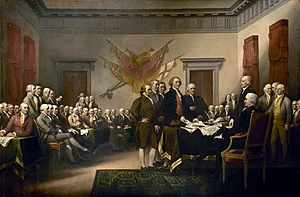Meet Jack Goldfarb, He was God-Father to my first wife.
In 1933 a Hungarian Jew got off the boat at Ellis Island, looking for a place to start a knitwear cut- and-sew operation. His name was Jack Goldfarb and he started out by producing knitwear in New York City. He bought the Fruit of the Loom brand in the 1940s. Then, in 1953 he built a completely vertical underwear production facility, over 3000 people, from knitting cloth to bleaching and dying it, then cutting and sewing it, all under one roof. It was the first factory of its kind, the largest ‘vertical factory’ until the Chinese built a bigger one in the 1980s.
Mr Goldfarb was a really nice man, old school, and a regular visitor to that factory although he lived in Chicago. And he became a favorite for the 2000 sewing ladies who worked there for several years. He had that singular quality of remembering his employees’ names. My wife, the daughter of the factory general manager, was his God-daughter.
Mr Goldfarb did not witness FOL’s closing its US manufacturing operations in the United States. He passed away in 1978, but not before FOL had built a big vertical factory in Louisiana, and another in Kentucky. But being “old school”, he never stopped pitching the ideal of workers’ connectedness to their work and management’s connection to its production workers. A seamless community. He also built a new corporate HQ, also in Kentucky, bringing all the functions of a modern corporate enterprise under one roof, from Planning, to Finance, and even Sales and Shipping. He then sold the company to William Farley, an entrepreneur who added FOL to his collection at Northwest Industries in Chicago.
Unknown to Mr Goldfarb the handshake between the Boss and those thousands of workers melted away.
My father-in-law, a WWII veteran, said Farley was the smartest businessman he’d ever known, even though he was just three years older than me. But William Farley was part of that post-80s new-generation of corporate managers who’d never worn the uniform when generals still knew their troops by name. Instead they’d earned the label of the “Gordon Gekko generation”, from the 1987 film “Wall Street” and whose world view redefined the attitudes and vision of the men and women who turned American business around…only not for the better.
They saw “the Company” thru a succession of departmental board rooms 2-3 floors beneath them, where ultimately they would discuss sending production orders to actual factories hundreds of miles away. In recent years Personnel Management departments have proliferated and grown in size, as a chosen preferred track for females. What they would know of their production factories would be from a series of reports, almost exclusively numbers, whereas my father-in-law, a 30-year senior executive would spend half hls day on the factory floor. His opinion of wage-and-hour people were very different from the middle management class that would succeed him in our new headquarters in the late 80s.
And their opinions of wage-and-hour workers were very low. One fellow from the Planning Department once proclaimed to me at a meeting, “I can train monkeys to make underwear. What I need is for it to cost 20% less.”
Thus spawned this connection to where the American working class now stands vis a vis our management class, and why, in Delaware, Joe Biden found a career around one of those long tables.
We cannot allow ourselves to forget that America was built on the American production ethic, not its management ethic.
And it began with the writing of the Declaration of Independence, which was written by and for the American citizen, by a young, ordinary citizen, explained by a Thomas Paine and his short 55-page pamphlet, “Common Sense”.https://www.davidmpoff.com/2022/07/04/attempting-the-overthrow-of-a-free-people/. It was not written by or for a university department head nor a company desk clerk. It was read by virtually every adult citizen in the Colonies, and America’s “Declaration of Independence” was a direct result of that book. And the people demanded it be molded in a declaration of independence.
A little flowery in the lingo of the 1770s, David Poff, the blind writer and keeper of his best friends in New Hampshire, large dogs, redid Paine’s “Common Sense” in modern vocabulary and I suggest you put all three volumes on your bookshelf (available on Amazon). That was the specific mission that the people of the several colonies gave to the Congress that had gathered in Philadelphia, and the only reading (to my knowledge) that caused a roomful of Soviet academicians to cry in 1992 as I toasted one of their professors. In 2015 I did a piece about those professors gathered around to celebrate that professor at his birthday party and it’s important to note that it had struck a chord despite the nation’s insistence that they ignore such sentiments as “liberty”. That this was in Kharkov, Ukraine, at the time still the Soviet Union, says much about the universality of the itch most of those professors possessed.
As my story tells, they got it, and they cried. But Ukraine’s political leaders never did, no more than Russia’s.
Which leads us to, in 2015, when Donald Trump came down that stairway in New York with his wife, his mind set on giving to America the same sort of gift the Founders had in mind in Philadelphia July 4, 1776.

If you saw any part of that debate between Donald Trump and Joe Biden the other night, (June 28, 2024) you realized that on almost any subject Trump sees America from the bottom-up, while Biden’s vision is exclusively from the board room, and his sole source of information is from memos by staff underlings. He has very little personal knowledge about anything that pertains to governance.
Something tells me Trump’s vision might still work out….something old being re-discovered as new maybe just the right formula, Donald Trump has tapped that. And it invokes Natural Law.



